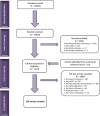Quality improvement strategies to prevent falls in older adults: a systematic review and network meta-analysis
- PMID: 30721919
- PMCID: PMC6503939
- DOI: 10.1093/ageing/afy219
Quality improvement strategies to prevent falls in older adults: a systematic review and network meta-analysis
Abstract
Background: Falls are a common occurrence and the most effective quality improvement (QI) strategies remain unclear.
Methods: We conducted a systematic review and network meta-analysis (NMA) to elucidate effective quality improvement (QI) strategies for falls prevention. Multiple databases were searched (inception-April 2017). We included randomised controlled trials (RCTs) of falls prevention QI strategies for participants aged ≥65 years. Two investigators screened titles and abstracts, full-text articles, conducted data abstraction and appraised risk of bias independently.
Results: A total of 126 RCTs including 84,307 participants were included after screening 10,650 titles and abstracts and 1210 full-text articles. NMA including 29 RCTs and 26,326 patients found that team changes was statistically superior in reducing the risk of injurious falls relative to usual care (odds ratio [OR] 0.57 [0.33 to 0.99]; absolute risk difference [ARD] -0.11 [95% CI, -0.18 to -0.002]). NMA for the outcome of number of fallers including 61 RCTs and 40 128 patients found that combined case management, patient reminders and staff education (OR 0.18 [0.07 to 0.47]; ARD -0.27 [95% CI, -0.33 to -0.15]) and combined case management and patient reminders (OR, 0.36 [0.13 to 0.97]; ARD -0.19 [95% CI, -0.30 to -0.01]) were both statistically superior compared to usual care.
Conclusions: Team changes may reduce risk of injurious falls and a combination of case management, patient reminders, and staff education, as well as case management and patient reminders may reduce risk of falls. Our results can be tailored to decision-maker preferences and availability of resources.
Systematic review registration: PROSPERO (CRD42013004151).
Keywords: fall prevention; falling; falls; older people; quality improvement; systematic review.
© The Author(s) 2019. Published by Oxford University Press on behalf of the British Geriatrics Society. All rights reserved. For permissions, please email: journals.permissions@oup.com.
References
-
- Note: The first 30 cited references in this manuscript are listed below. For the remaining references, please refer to Supplement 2: Appendix O in the supplementary data, available at Age and Ageing online.
-
- Parry SW, Deary V, Finch T et al. . The STRIDE (Strategies to Increase confidence, InDependence and Energy) study: cognitive behavioural therapy-based intervention to reduce fear of falling in older fallers living in the community—study protocol for a randomised controlled trial. Trials 2014; 15: 210. - PMC - PubMed
-
- Ray WA, Taylor JA, Brown AK et al. . Prevention of fall-related injuries in long-term care: a randomized controlled trial of staff education. Arch Intern Med 2005; 165: 2293–8. - PubMed
Publication types
MeSH terms
Grants and funding
LinkOut - more resources
Full Text Sources
Medical
Miscellaneous


